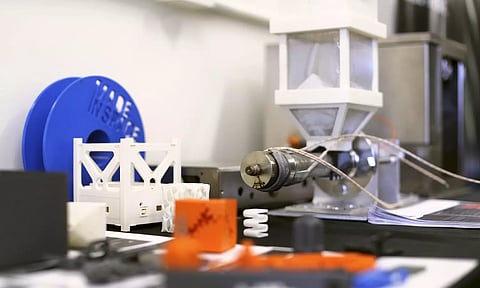

NEW DELHI: From existing as a fictional concept in books in the 1940s to being developed in the 1980s and becoming viable in the 2000s, 3D printing has come a long way, allowing faster and more accurate construction of structures, potentially even in environments not suitable for humans such as in space.
India got its first 3D-printed post office in Bengaluru on Friday.
3D printing in construction, called 3D construction printing (3DCP) or additive construction, uses the technology to fabricate components or entire buildings. The technique allows for speedy construction of complex structures along with lowering labour costs and producing lesser waste.
So, what is this technology? What are its applications and what are its prospects? Here is an explainer:
3D printing, also called additive manufacturing, is the construction of a three-dimensional object from a computer or a digital model and it is achieved through varied processes. Material can either be deposited, joined or solidified under computer control, with it being generally added layer by layer.
3D printing of materials, such as metals and alloys, can be employed to enhance their physical properties like strength and thermal resilience.
This has immense implications for manufacturing processes and, in turn, on sectors depending on it such as aviation and defence. The enhanced materials encourage design of fuel and energy efficient turbines and engines, according to researchers at the Massachusetts Institute of Technology (MIT).
Engineers at the University of Arizona are developing materials that can withstand travelling at speeds at least five times faster than the speed of sound. They could, therefore, be used in 3D printing components for hypersonic vehicles in defence, they say.
3D printing processes are also being exploited by projects led by US space agency NASA and these are aimed at manufacturing rechargeable batteries using lunar and Martian soil, according to a paper published in the journal ACS Energy Letters that details their research's progress.
Scientists are also strategising on how to leverage currently-available 3D printers in creating materials that would blend solid and liquid components, a process that, researchers at the University of Colorado Boulder, believe could be used in fabricating a complete system such as a robot.
At the Singapore University of Technology and Design, research is also underway to 3D print more robust and geometrically complex components for soft robotics, which are made of compliant materials instead of rigid joints and more closely resemble the physical characteristics of living organisms.
By mixing solids and liquids, scientists believe that 3D printers could churn out more flexible, dynamic and potentially more useful devices. These could include wearable electronic devices with wires made of liquid contained within solid layers, or even models that mimic the squishiness of real human organs.
3D bioprinting is a technique where live human cells are mixed with bioinks, or substances made of living cells used for 3D printing of complex tissue models, and deposited in a specific manner to reproduce the micro-environment of native organs.
For example, researchers at MIT have developed a procedure to 3D print a soft and flexible replica of a patient's heart. The replica could then be controlled to mimic the patient's blood-pumping ability and could help in tailoring treatments to patients' specific heart form and function.
While 3D printing organs holds promise for solving the shortage of organs available for transplants, the idea continues to be fraught with complexity and technical barriers.
3D bioprinting also has utility in cancer research where a 3D bioprinter, developed by scientists at the University of Cambridge, is capable of quickly manufacturing 3D cell assemblies resembling tumour tissues. It can help test potential immunotherapy treatments.
Besides manufacturing and health, 3D printing has massive potential for research and innovation in the food industry, despite multiple challenges in its applications.
For instance, scientists at Rutgers University have developed a formulation of low-fat chocolate that can be 3D printed by substituting fatty cocoa butter with a lower-fat, water-in-oil emulsion. The aim is to create a healthier chocolate easily accessible to consumers.
While it might seem that 3D printing food could address global challenges in food supply and nutrition, scientists say there are hurdles involved in adapting 3D printing to produce edible materials.
One of these involve the low-nutrient value of such foods, because 3D printed foods are still processed foods. They, however, do offer an individual more control over and tailoring of nutrition, thereby, providing means for personalised nutrition.
The customisability in 3D food printing renders it particularly practical for the plant-based meat market, where texture and flavour need to be carefully formulated to mimic real meats, researchers at the Columbia University say. The personalised techniques could be very useful and convenient in planning meals for people with dietary restrictions, young children and athletes.
Further, because 3D food printing uses high-energy targeted light for high-resolution tailored heating, cooking could become more cost-effective and more sustainable, food scientists have said.
4D printing involves 3D printers to create live three dimensional objects without wires or circuits by using intelligent materials, which can be programmed to change shape, colour or size upon being externally stimulated.